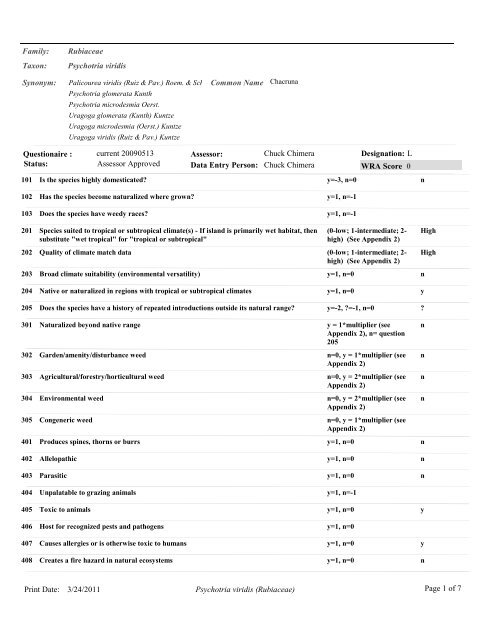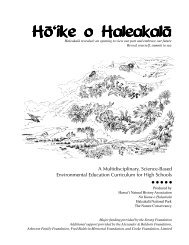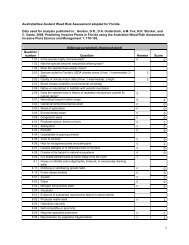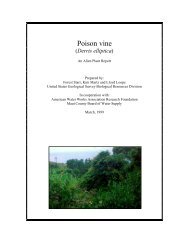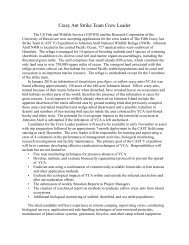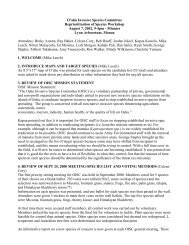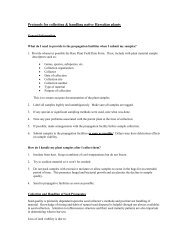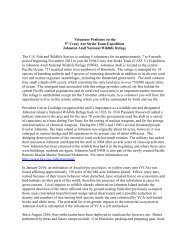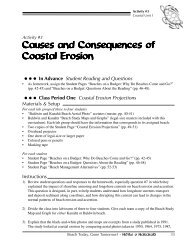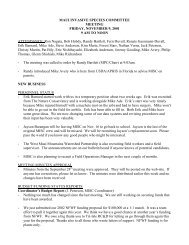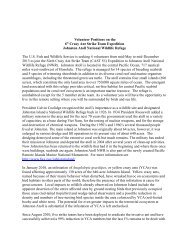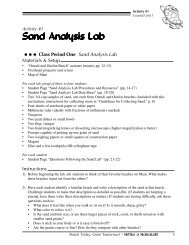Psychotria Viridis
Psychotria Viridis
Psychotria Viridis
Create successful ePaper yourself
Turn your PDF publications into a flip-book with our unique Google optimized e-Paper software.
Family:<br />
Rubiaceae<br />
Taxon:<br />
<strong>Psychotria</strong> viridis<br />
Synonym:<br />
Palicourea viridis (Ruiz & Pav.) Roem. & Sch<br />
<strong>Psychotria</strong> glomerata Kunth<br />
<strong>Psychotria</strong> microdesmia Oerst.<br />
Uragoga glomerata (Kunth) Kuntze<br />
Uragoga microdesmia (Oerst.) Kuntze<br />
Uragoga viridis (Ruiz & Pav.) Kuntze<br />
Common Name<br />
Chacruna<br />
Questionaire : current 20090513<br />
Status:<br />
Assessor Approved<br />
Assessor:<br />
Chuck Chimera<br />
Designation: L<br />
Data Entry Person: Chuck Chimera WRA Score 0<br />
101 Is the species highly domesticated?<br />
y=-3, n=0<br />
n<br />
102 Has the species become naturalized where grown?<br />
y=1, n=-1<br />
103 Does the species have weedy races?<br />
y=1, n=-1<br />
201 Species suited to tropical or subtropical climate(s) - If island is primarily wet habitat, then (0-low; 1-intermediate; 2- High<br />
substitute "wet tropical" for "tropical or subtropical"<br />
high) (See Appendix 2)<br />
202 Quality of climate match data<br />
(0-low; 1-intermediate; 2- High<br />
high) (See Appendix 2)<br />
203 Broad climate suitability (environmental versatility)<br />
y=1, n=0<br />
n<br />
204 Native or naturalized in regions with tropical or subtropical climates<br />
y=1, n=0<br />
y<br />
205 Does the species have a history of repeated introductions outside its natural range? y=-2, ?=-1, n=0<br />
?<br />
301 Naturalized beyond native range<br />
y = 1*multiplier (see n<br />
Appendix 2), n= question<br />
205<br />
302 Garden/amenity/disturbance weed<br />
n=0, y = 1*multiplier (see n<br />
Appendix 2)<br />
303 Agricultural/forestry/horticultural weed<br />
n=0, y = 2*multiplier (see n<br />
Appendix 2)<br />
304 Environmental weed<br />
n=0, y = 2*multiplier (see n<br />
Appendix 2)<br />
305 Congeneric weed<br />
n=0, y = 1*multiplier (see<br />
Appendix 2)<br />
401 Produces spines, thorns or burrs<br />
y=1, n=0<br />
n<br />
402 Allelopathic<br />
y=1, n=0<br />
n<br />
403 Parasitic<br />
y=1, n=0<br />
n<br />
404 Unpalatable to grazing animals<br />
y=1, n=-1<br />
405 Toxic to animals<br />
y=1, n=0<br />
y<br />
406 Host for recognized pests and pathogens<br />
y=1, n=0<br />
407 Causes allergies or is otherwise toxic to humans<br />
y=1, n=0<br />
y<br />
408 Creates a fire hazard in natural ecosystems<br />
y=1, n=0<br />
n<br />
Print Date: 3/24/2011 <strong>Psychotria</strong> viridis (Rubiaceae)<br />
Page 1 of 7
409 Is a shade tolerant plant at some stage of its life cycle<br />
y=1, n=0<br />
y<br />
410 Tolerates a wide range of soil conditions (or limestone conditions if not a volcanic island) y=1, n=0<br />
n<br />
411 Climbing or smothering growth habit<br />
y=1, n=0<br />
n<br />
412 Forms dense thickets<br />
y=1, n=0<br />
n<br />
501 Aquatic<br />
y=5, n=0<br />
n<br />
502 Grass<br />
y=1, n=0<br />
n<br />
503 Nitrogen fixing woody plant<br />
y=1, n=0<br />
n<br />
504 Geophyte (herbaceous with underground storage organs -- bulbs, corms, or tubers) y=1, n=0<br />
n<br />
601 Evidence of substantial reproductive failure in native habitat<br />
y=1, n=0<br />
n<br />
602 Produces viable seed<br />
y=1, n=-1<br />
y<br />
603 Hybridizes naturally<br />
y=1, n=-1<br />
604 Self-compatible or apomictic<br />
y=1, n=-1<br />
y<br />
605 Requires specialist pollinators<br />
y=-1, n=0<br />
n<br />
606 Reproduction by vegetative fragmentation<br />
y=1, n=-1<br />
n<br />
607 Minimum generative time (years)<br />
1 year = 1, 2 or 3 years = 0,<br />
4+ years = -1<br />
701 Propagules likely to be dispersed unintentionally (plants growing in heavily trafficked y=1, n=-1<br />
n<br />
areas)<br />
702 Propagules dispersed intentionally by people<br />
y=1, n=-1<br />
y<br />
703 Propagules likely to disperse as a produce contaminant<br />
y=1, n=-1<br />
n<br />
704 Propagules adapted to wind dispersal<br />
y=1, n=-1<br />
n<br />
705 Propagules water dispersed<br />
y=1, n=-1<br />
n<br />
706 Propagules bird dispersed<br />
y=1, n=-1<br />
y<br />
707 Propagules dispersed by other animals (externally)<br />
y=1, n=-1<br />
n<br />
708 Propagules survive passage through the gut<br />
y=1, n=-1<br />
y<br />
801 Prolific seed production (>1000/m2)<br />
y=1, n=-1<br />
n<br />
802 Evidence that a persistent propagule bank is formed (>1 yr)<br />
y=1, n=-1<br />
n<br />
803 Well controlled by herbicides<br />
y=-1, n=1<br />
804 Tolerates, or benefits from, mutilation, cultivation, or fire<br />
y=1, n=-1<br />
805 Effective natural enemies present locally (e.g. introduced biocontrol agents)<br />
y=-1, n=1<br />
Designation: L<br />
WRA Score 0<br />
Print Date: 3/24/2011 <strong>Psychotria</strong> viridis (Rubiaceae)<br />
Page 2 of 7
Supporting Data:<br />
101 2009. Plot55.com. Growing <strong>Psychotria</strong> viridis.<br />
http://www.plot55.com/growing/p.viridis.html<br />
102 2009. WRA Specialist. Personal Communication. NA<br />
103 2009. WRA Specialist. Personal Communication. NA<br />
201 1980. Woodson, Jr., R.E./Schery, R.W./Dwyer,<br />
J.D.. Flora of Panama. Part IX. Family 179.<br />
Rubiaceae. Part 2. Annals of the Missouri<br />
Botanical Garden. 67(2): 257-522.<br />
202 1980. Woodson, Jr., R.E./Schery, R.W./Dwyer,<br />
J.D.. Flora of Panama. Part IX. Family 179.<br />
Rubiaceae. Part 2. Annals of the Missouri<br />
Botanical Garden. 67(2): 257-522.<br />
203 2009. Dave's Garden. PlantFiles: Chacruna -<br />
<strong>Psychotria</strong> viridis.<br />
http://davesgarden.com/guides/pf/go/92028/<br />
203 2009. Ethnogarden Botanicals. Chacruna<br />
(<strong>Psychotria</strong> <strong>Viridis</strong>).<br />
http://www.ethnogarden.com/botanicals/liveplants/chacruna-psychotria-viridis-live-plant.html<br />
204 1980. Woodson, Jr., R.E./Schery, R.W./Dwyer,<br />
J.D.. Flora of Panama. Part IX. Family 179.<br />
Rubiaceae. Part 2. Annals of the Missouri<br />
Botanical Garden. 67(2): 257-522.<br />
205 2009. EthnoBotanyLabs. <strong>Psychotria</strong> viridis.<br />
http://www.eblabs.com/retail/psychotria_viridis.ht<br />
m<br />
205 2009. Shaman's Garden. <strong>Psychotria</strong> <strong>Viridis</strong><br />
Seeds. http://www.shamansgarden.com/p-250-<br />
psychotria-viridis-seeds-chacruna.aspx<br />
301 2007. Randall, R.P.. Global Compendium of<br />
Weeds - Index [Online Database].<br />
http://www.hear.org/gcw/<br />
302 2007. Randall, R.P.. Global Compendium of<br />
Weeds - Index [Online Database].<br />
http://www.hear.org/gcw/<br />
303 2007. Randall, R.P.. Global Compendium of<br />
Weeds - Index [Online Database].<br />
http://www.hear.org/gcw/<br />
304 2007. Randall, R.P.. Global Compendium of<br />
Weeds - Index [Online Database].<br />
http://www.hear.org/gcw/<br />
305 1979. Holm, L. G./Pancho, J.V./Herberger,<br />
J.P./Plucknett, D.L.. A Geographical Atlas of<br />
World Weeds. John Wiley and Sons, New York,<br />
NY<br />
305 2007. Randall, R.P.. Global Compendium of<br />
Weeds - Index [Online Database].<br />
http://www.hear.org/gcw/<br />
401 1980. Woodson, Jr., R.E./Schery, R.W./Dwyer,<br />
J.D.. Flora of Panama. Part IX. Family 179.<br />
Rubiaceae. Part 2. Annals of the Missouri<br />
Botanical Garden. 67(2): 257-522.<br />
"<strong>Psychotria</strong> viridis is native to the Amazonian lowlands, but is also cultivated<br />
throughout northern South America and much of Central America. It is an<br />
evergreen tropical tree or large shrub growing in full sun to half shade. It has<br />
large (up to 24cm) leaves, which are oval with pointed tips. Its small brown seeds<br />
are shed from red berries. It usually grows in very rich and fertile soils." [no<br />
evidence]<br />
"<strong>Psychotria</strong> viridis extends from Belize to Bolivia. It also occurs in Cuba."<br />
"<strong>Psychotria</strong> viridis extends from Belize to Bolivia. It also occurs in Cuba."<br />
"Hardiness: USDA Zone 10b: to 1.7 °C (35 °F)"<br />
"These plants like a nutrient-rich, well draining soil, and will thrive and grow rather<br />
quickly during the summer months. Temperatures below 65 F are not advisable;<br />
this plant will not tolerate frost. Temperatures above 70 F are optimal for growing,<br />
with a range of 80-90 F being ideal. These plants prefer partial shade and moist<br />
environments."<br />
"<strong>Psychotria</strong> viridis extends from Belize to Bolivia. It also occurs in Cuba."<br />
"Live <strong>Psychotria</strong> viridis plants are sometimes offered for sale during the spring<br />
summer and fall. If you see the buy link below, we have them in stock. Or try and<br />
grow your own by buying some seeds." [live plants and seeds widely available,<br />
but unknown how many countries into which this plant has been introduced]<br />
"<strong>Psychotria</strong> viridis Seeds (Chacruna) These are viable, untreated seeds from a<br />
small organic farm in Hawaii that provides the well-known Hawaiian Salvia plants.<br />
<strong>Psychotria</strong> viridis (Chacruna) is a shrub in the coffee family. "<br />
No evidence<br />
No evidence<br />
No evidence<br />
No evidence<br />
<strong>Psychotria</strong> alba [listed as a weed]<br />
<strong>Psychotria</strong> barbiflora (Rubiaceae) [listed as a weed]; <strong>Psychotria</strong> curviflora [listed<br />
as an agricultural weed]; <strong>Psychotria</strong> nervosa [listed as an agricultural weed];<br />
<strong>Psychotria</strong> pubescens [listed as an agricultural weed]; <strong>Psychotria</strong> punctata [listed<br />
as a weed]; <strong>Psychotria</strong> ruelliaefolia [listed as a weed] [no further information on<br />
impacts or control efforts on any of the preceding species was found]<br />
"Small trees or shrubs, the twiglets slender, smooth, glabrous or puberulent,<br />
terete but ultimately angular, the nodes well spaced."<br />
Print Date: 3/24/2011 <strong>Psychotria</strong> viridis (Rubiaceae)<br />
Page 3 of 7
402 1975. Standley, P.C./Williams, L.O.. Flora of<br />
Guatemala - Part XI. Numbers 1 to 3. Fieldiana.<br />
24: 1-274.<br />
403 1980. Woodson, Jr., R.E./Schery, R.W./Dwyer,<br />
J.D.. Flora of Panama. Part IX. Family 179.<br />
Rubiaceae. Part 2. Annals of the Missouri<br />
Botanical Garden. 67(2): 257-522.<br />
404 1996. Leal, M.B./Elisabetsky, E.. Absence of<br />
alkaloids in <strong>Psychotria</strong> carthagenensis Jacq.<br />
(Rubiaceae). Journal of Ethnopharmacology. 54:<br />
37-40.<br />
404 2009. B and T World Seeds. <strong>Psychotria</strong> viridis.<br />
http://b-and-t-worldseeds.com/carth.asp?species=<strong>Psychotria</strong>%20viri<br />
dis&sref=391<br />
405 1996. Leal, M.B./Elisabetsky, E.. Absence of<br />
alkaloids in <strong>Psychotria</strong> carthagenensis Jacq.<br />
(Rubiaceae). Journal of Ethnopharmacology. 54:<br />
37-40.<br />
"<strong>Psychotria</strong> viridis Ruiz & Pavon, Fl. Peruv. 2: 61, t. 210, f. b. 1799. P. glomerata<br />
HBK. Nov. Gen. & Sp. 3: 363. 1820. P. microdesmia Oerst. Vid. Medd.<br />
Kjoebenhavn 1852: 36. 1853. Moist or wet thickets or forest, on limestone, 150<br />
m. or less; Peten. Collected at Cocquericot, British Honduras; Costa Rica and<br />
Panama; southward to Bolivia and the Guianas; Cuba." [no evidence]<br />
"Small trees or shrubs, the twiglets slender, smooth, glabrous or puberulent,<br />
terete but ultimately angular, the nodes well spaced." Rubiaceae, not parasitic]<br />
"The genus <strong>Psychotria</strong> is very closely allied to Palicourea (Rubiaceae) (Schultes<br />
and Rauffauf, 1990). Several species of <strong>Psychotria</strong> and Palicourea are reported<br />
as fairly to highly toxic, usually affecting cattle. "<br />
"Parts of <strong>Psychotria</strong> viridis are considered toxic." [plants probably unpalatable,<br />
but possible that cattle may ingest plants and become poisoned inadvertently]<br />
"The genus <strong>Psychotria</strong> is very closely allied to Palicourea (Rubiaceae) (Schultes<br />
and Rauffauf, 1990). Several species of <strong>Psychotria</strong> and Palicourea are reported<br />
as fairly to highly toxic, usually affecting cattle."<br />
405 2009. B and T World Seeds. <strong>Psychotria</strong> viridis. "Parts of <strong>Psychotria</strong> viridis are considered toxic. "<br />
http://b-and-t-worldseeds.com/carth.asp?species=<strong>Psychotria</strong>%20viri<br />
dis&sref=391<br />
406 2009. WRA Specialist. Personal Communication. Unknown<br />
407 2009. Dave's Garden. PlantFiles: Chacruna -<br />
<strong>Psychotria</strong> viridis.<br />
http://davesgarden.com/guides/pf/go/92028/<br />
407 2009. Ethnogarden Botanicals. Chacruna<br />
(<strong>Psychotria</strong> <strong>Viridis</strong>).<br />
http://www.ethnogarden.com/botanicals/liveplants/chacruna-psychotria-viridis-live-plant.html<br />
408 1975. Standley, P.C./Williams, L.O.. Flora of<br />
Guatemala - Part XI. Numbers 1 to 3. Fieldiana.<br />
24: 1-274.<br />
409 2009. Dave's Garden. PlantFiles: Chacruna -<br />
<strong>Psychotria</strong> viridis.<br />
http://davesgarden.com/guides/pf/go/92028/<br />
410 2009. B and T World Seeds. <strong>Psychotria</strong> viridis.<br />
http://b-and-t-worldseeds.com/carth.asp?species=<strong>Psychotria</strong>%20viri<br />
dis&sref=391<br />
410 2009. Ethnogarden Botanicals. Chacruna<br />
(<strong>Psychotria</strong> <strong>Viridis</strong>).<br />
http://www.ethnogarden.com/botanicals/liveplants/chacruna-psychotria-viridis-live-plant.html<br />
"Danger: Parts of plant are poisonous if ingested"<br />
"This product and all other materials on this site are sold as poisonous nonconsumables."<br />
"<strong>Psychotria</strong> viridis Ruiz & Pavon, Fl. Peruv. 2: 61, t. 210, f. b. 1799. P. glomerata<br />
HBK. Nov. Gen. & Sp. 3: 363. 1820. P. microdesmia Oerst. Vid. Medd.<br />
Kjoebenhavn 1852: 36. 1853. Moist or wet thickets or forest, on limestone, 150<br />
m. or less; Peten. Collected at Cocquericot, British Honduras; Costa Rica and<br />
Panama; southward to Bolivia and the Guianas; Cuba." [no evidence, and occurs<br />
in moist tropical forests]<br />
"Sun Exposure: Partial to Full Shade Full Shade"<br />
"<strong>Psychotria</strong> viridis is cultivated in sandy loam - light soils with good drainage"<br />
"These plants like a nutrient-rich, well draining soil,"<br />
410 2009. Plants and Cacti .com. <strong>Psychotria</strong> <strong>Viridis</strong> "A very rich and fertile free draining soil is best."<br />
Plants. http://www.plantsandcacti.com/psychotriaviridis-plants.php<br />
411 1980. Woodson, Jr., R.E./Schery, R.W./Dwyer,<br />
J.D.. Flora of Panama. Part IX. Family 179.<br />
Rubiaceae. Part 2. Annals of the Missouri<br />
Botanical Garden. 67(2): 257-522.<br />
412 1975. Standley, P.C./Williams, L.O.. Flora of<br />
Guatemala - Part XI. Numbers 1 to 3. Fieldiana.<br />
24: 1-274.<br />
"Small trees or shrubs, the twiglets slender, smooth, glabrous or puberulent,<br />
terete but ultimately angular, the nodes well spaced." [not climbing or smothering]<br />
"<strong>Psychotria</strong> viridis Ruiz & Pavon, Fl. Peruv. 2: 61, t. 210, f. b. 1799. P. glomerata<br />
HBK. Nov. Gen. & Sp. 3: 363. 1820. P. microdesmia Oerst. Vid. Medd.<br />
Kjoebenhavn 1852: 36. 1853. Moist or wet thickets or forest, on limestone, 150<br />
m. or less; Peten. Collected at Cocquericot, British Honduras; Costa Rica and<br />
Panama; southward to Bolivia and the Guianas; Cuba." [no evidence]<br />
Print Date: 3/24/2011 <strong>Psychotria</strong> viridis (Rubiaceae)<br />
Page 4 of 7
501 1980. Woodson, Jr., R.E./Schery, R.W./Dwyer,<br />
J.D.. Flora of Panama. Part IX. Family 179.<br />
Rubiaceae. Part 2. Annals of the Missouri<br />
Botanical Garden. 67(2): 257-522.<br />
502 1980. Woodson, Jr., R.E./Schery, R.W./Dwyer,<br />
J.D.. Flora of Panama. Part IX. Family 179.<br />
Rubiaceae. Part 2. Annals of the Missouri<br />
Botanical Garden. 67(2): 257-522.<br />
503 1980. Woodson, Jr., R.E./Schery, R.W./Dwyer,<br />
J.D.. Flora of Panama. Part IX. Family 179.<br />
Rubiaceae. Part 2. Annals of the Missouri<br />
Botanical Garden. 67(2): 257-522.<br />
504 1980. Woodson, Jr., R.E./Schery, R.W./Dwyer,<br />
J.D.. Flora of Panama. Part IX. Family 179.<br />
Rubiaceae. Part 2. Annals of the Missouri<br />
Botanical Garden. 67(2): 257-522.<br />
601 1980. Woodson, Jr., R.E./Schery, R.W./Dwyer,<br />
J.D.. Flora of Panama. Part IX. Family 179.<br />
Rubiaceae. Part 2. Annals of the Missouri<br />
Botanical Garden. 67(2): 257-522.<br />
602 1989. Hamilton, C.W.. A Revision of<br />
Mesoamerican <strong>Psychotria</strong> Subgenus <strong>Psychotria</strong><br />
(Rubiaceae). Part I: Introduction and Species 1-<br />
16. Annals of the Missouri Botanical Garden.<br />
76(1): 67-111.<br />
602 2009. The Basement Shaman. <strong>Psychotria</strong> viridis<br />
seeds.<br />
http://www.basementshaman.com/psycvir1.html<br />
Terrestrial<br />
Rubiaceae<br />
603 2009. WRA Specialist. Personal Communication. Unknown<br />
604 2009. The Corroboree. is psychotria viridis selfpollinating?.<br />
http://www.shamanaustralis.com/forum/index.php?showtopic=2434&<br />
pid=19460&mode=threaded&start=<br />
605 1980. Woodson, Jr., R.E./Schery, R.W./Dwyer,<br />
J.D.. Flora of Panama. Part IX. Family 179.<br />
Rubiaceae. Part 2. Annals of the Missouri<br />
Botanical Garden. 67(2): 257-522.<br />
606 2009. Wikipedia.org. <strong>Psychotria</strong> viridis.<br />
http://en.wikipedia.org/wiki/<strong>Psychotria</strong>_viridis<br />
Rubiaceae [not a nitrogen fixing woody plant]<br />
"Small trees or shrubs, the twiglets slender, smooth, glabrous or puberulent,<br />
terete but ultimately angular, the nodes well spaced." [not a geophyte]<br />
No evidence of substantial reproductive failure in native habitat<br />
"Seed dorsal surface with 4-5 deep longitudinal furrows, the ventral surface with 2<br />
deep longitudinal furrows. "<br />
"Fresh, viable seed from one of the most important plants used in the ayahuasca<br />
traditions of South America. <strong>Psychotria</strong> viridis seeds are slow to germinate, but<br />
will reward the patient gardener who wants to add this sacred ally to their<br />
shamanic garden."<br />
"is psychotria viridis self-pollinating? we got seed from a set of plants that were<br />
all clones of each other, so they are definitely self fertile."<br />
"Inflorescences terminal, spreading, paniculate, usually shorter than the<br />
uppermost leaves; peduncles 2-3 cm long, angular, glabrate, the rachis zigzag,<br />
the branches few, usually opposite, the flowers disposed in well separated, few<br />
flowered glomerules giving a spikelike appearance, the bracts caducous. Flowers<br />
sessile, minute; hypanthium short, rounded basally, puberulent, the calycine cup<br />
scarcely measurable, truncate, the teeth absent; corolla greenish white or white,<br />
the lobes 5, deltoid, apparently longer than the tube, to 1 mm long, densely white<br />
villose within; anthers subsessile, oblong, 0.35 mm long; ovarian disc<br />
compressed rotund, 0.6 mm long, the style ca. 0.4 mm long, conspicuously<br />
swollen above the middle, the stigmas ca. 0.15 mm long." [small, unspecialized<br />
flowers]<br />
"Cultivation from cuttings is easiest.[5] A single leaf (or even part of a leaf slightly<br />
covered with soil) can be sufficient for a cutting.[5] Propagation from seed is<br />
extremely difficult. The germination rate can be as low as 1%.[5] There are<br />
approximately 50 seeds/g." [no evidence]<br />
607 2009. Ethnobotanical Gardening Forum. Subject: "Plants were kept in a high humidity environment and even began to form roots<br />
Re: <strong>Psychotria</strong> viridis: fast grower?.<br />
on the underside of the leaves. Survival was fine in Southern California climate,<br />
http://www.lycaeum.org/forums/egarden/Message but growth was slow. High humidity required for new leaf development and<br />
s/1014.html<br />
overall health. The plants are about 1 year old and stand 12 cm tall."<br />
607 2009. Herbalistics. <strong>Psychotria</strong> viridis - Chacruna<br />
(seed).<br />
http://www.herbalistics.com.au/shop/product_info.<br />
php?products_id=467&osCsid=xaupeplryaj<br />
"Relatively fast growing, <strong>Psychotria</strong> viridis prefers a shady, moist, well-drained<br />
site." [possibly
701 1989. Hamilton, C.W.. A Revision of<br />
Mesoamerican <strong>Psychotria</strong> Subgenus <strong>Psychotria</strong><br />
(Rubiaceae). Part I: Introduction and Species 1-<br />
16. Annals of the Missouri Botanical Garden.<br />
76(1): 67-111.<br />
"Fruits when dry ellipsoidal, 4.5-5 mm long, 3-3.5 mm diam., maturing red, drying<br />
red brown" [no means of external attachment]<br />
702 2009. Bouncing Bear Botanicals. Chacruna. "We offer Chacruna Seeds sustainably harvested from Peru and dried foliage<br />
http://www.bouncingbearbotanicals.com/chacruna from Hawaii and Peru." [sold for propagation and medicinal uses]<br />
-p-114.html<br />
703 1980. Woodson, Jr., R.E./Schery, R.W./Dwyer,<br />
J.D.. Flora of Panama. Part IX. Family 179.<br />
Rubiaceae. Part 2. Annals of the Missouri<br />
Botanical Garden. 67(2): 257-522.<br />
703 1989. Hamilton, C.W.. A Revision of<br />
Mesoamerican <strong>Psychotria</strong> Subgenus <strong>Psychotria</strong><br />
(Rubiaceae). Part I: Introduction and Species 1-<br />
16. Annals of the Missouri Botanical Garden.<br />
76(1): 67-111.<br />
704 1980. Woodson, Jr., R.E./Schery, R.W./Dwyer,<br />
J.D.. Flora of Panama. Part IX. Family 179.<br />
Rubiaceae. Part 2. Annals of the Missouri<br />
Botanical Garden. 67(2): 257-522.<br />
704 1989. Hamilton, C.W.. A Revision of<br />
Mesoamerican <strong>Psychotria</strong> Subgenus <strong>Psychotria</strong><br />
(Rubiaceae). Part I: Introduction and Species 1-<br />
16. Annals of the Missouri Botanical Garden.<br />
76(1): 67-111.<br />
705 1980. Woodson, Jr., R.E./Schery, R.W./Dwyer,<br />
J.D.. Flora of Panama. Part IX. Family 179.<br />
Rubiaceae. Part 2. Annals of the Missouri<br />
Botanical Garden. 67(2): 257-522.<br />
705 1989. Hamilton, C.W.. A Revision of<br />
Mesoamerican <strong>Psychotria</strong> Subgenus <strong>Psychotria</strong><br />
(Rubiaceae). Part I: Introduction and Species 1-<br />
16. Annals of the Missouri Botanical Garden.<br />
76(1): 67-111.<br />
706 1980. Woodson, Jr., R.E./Schery, R.W./Dwyer,<br />
J.D.. Flora of Panama. Part IX. Family 179.<br />
Rubiaceae. Part 2. Annals of the Missouri<br />
Botanical Garden. 67(2): 257-522.<br />
706 1989. Hamilton, C.W.. A Revision of<br />
Mesoamerican <strong>Psychotria</strong> Subgenus <strong>Psychotria</strong><br />
(Rubiaceae). Part I: Introduction and Species 1-<br />
16. Annals of the Missouri Botanical Garden.<br />
76(1): 67-111.<br />
707 1980. Woodson, Jr., R.E./Schery, R.W./Dwyer,<br />
J.D.. Flora of Panama. Part IX. Family 179.<br />
Rubiaceae. Part 2. Annals of the Missouri<br />
Botanical Garden. 67(2): 257-522.<br />
707 1989. Hamilton, C.W.. A Revision of<br />
Mesoamerican <strong>Psychotria</strong> Subgenus <strong>Psychotria</strong><br />
(Rubiaceae). Part I: Introduction and Species 1-<br />
16. Annals of the Missouri Botanical Garden.<br />
76(1): 67-111.<br />
708 1980. Woodson, Jr., R.E./Schery, R.W./Dwyer,<br />
J.D.. Flora of Panama. Part IX. Family 179.<br />
Rubiaceae. Part 2. Annals of the Missouri<br />
Botanical Garden. 67(2): 257-522.<br />
708 2009. The Basement Shaman. <strong>Psychotria</strong> viridis<br />
seeds.<br />
http://www.basementshaman.com/psycvir1.html<br />
"Fruits fleshy, the flesh usually soon deciduous exposing 2 pyrenes, the endocarp<br />
of the pyrene ventrally flat or grooved, dorsally costate or ecostate, the testa thin,<br />
the albumen hard, sometimes ruminate."[genus description]<br />
"Fruits when dry ellipsoidal, 4.5-5 mm long, 3 3.5 mm diam., maturing red, drying<br />
red brown" [no evidence that plant is grown with or contaminates other produce]<br />
"Fruits fleshy, the flesh usually soon deciduous exposing 2 pyrenes, the endocarp<br />
of the pyrene ventrally flat or grooved, dorsally costate or ecostate, the testa thin,<br />
the albumen hard, sometimes ruminate." [genus description]<br />
"Fruits when dry ellipsoidal, 4.5-5 mm long, 3-3.5 mm diam., maturing red, drying<br />
red brown"<br />
"Fruits fleshy, the flesh usually soon deciduous exposing 2 pyrenes, the endocarp<br />
of the pyrene ventrally flat or grooved, dorsally costate or ecostate, the testa thin,<br />
the albumen hard, sometimes ruminate." [genus description]<br />
"Fruits when dry ellipsoidal, 4.5-5 mm long, 3 3.5 mm diam., maturing red, drying<br />
red brown" [no evidence]<br />
"Fruits fleshy, the flesh usually soon deciduous exposing 2 pyrenes, the endocarp<br />
of the pyrene ventrally flat or grooved, dorsally costate or ecostate, the testa thin,<br />
the albumen hard, sometimes ruminate." [genus description]<br />
"Fruits when dry ellipsoidal, 4.5-5 mm long, 3-3.5 mm diam., maturing red, drying<br />
red brown "<br />
"Fruits fleshy, the flesh usually soon deciduous exposing 2 pyrenes, the endocarp<br />
of the pyrene ventrally flat or grooved, dorsally costate or ecostate, the testa thin,<br />
the albumen hard, sometimes ruminate." [genus description]<br />
"Fruits when dry ellipsoidal, 4.5-5 mm long, 3-3.5 mm diam., maturing red, drying<br />
red brown" [no evidence and no means of external attachment]<br />
"Fruits fleshy, the flesh usually soon deciduous exposing 2 pyrenes, the endocarp<br />
of the pyrene ventrally flat or grooved, dorsally costate or ecostate, the testa thin,<br />
the albumen hard, sometimes ruminate." [genus description]<br />
:Fruits when dry ellipsoidal, 4.5-5 mm long, 3-3.5 mm diam., maturing red, drying<br />
red brown"<br />
Print Date: 3/24/2011 <strong>Psychotria</strong> viridis (Rubiaceae)<br />
Page 6 of 7
801 1980. Woodson, Jr., R.E./Schery, R.W./Dwyer,<br />
J.D.. Flora of Panama. Part IX. Family 179.<br />
Rubiaceae. Part 2. Annals of the Missouri<br />
Botanical Garden. 67(2): 257-522.<br />
802 2009. Dave's Garden. PlantFiles: Chacruna -<br />
<strong>Psychotria</strong> viridis.<br />
http://davesgarden.com/guides/pf/go/92028/<br />
802 2009. World Seed Supply. Growing <strong>Psychotria</strong><br />
<strong>Viridis</strong> from Seed and Cuttings.<br />
http://worldseedsupplydotnet.blogspot.com/2009/<br />
10/growing-psychotria-viridis-from-seed.html<br />
803 2009. WRA Specialist. Personal Communication. Unknown [no information on control]<br />
804 2009. WRA Specialist. Personal Communication. Unknown<br />
"Small trees or shrubs, the twiglets slender, smooth, glabrous or puberulent,<br />
terete but ultimately angular, the nodes well spaced...Inflorescences terminal,<br />
spreading, paniculate, usually shorter than the uppermost leaves; peduncles 2-3<br />
cm long, angular, glabrate, the rachis zigzag, the branches few, usually opposite,<br />
the flowers disposed in well separated, few-flowered glomerules giving a spikelike<br />
appearance, the bracts caducous. Flowers sessile, minute; hypanthium short,<br />
rounded basally, puberulent, the calycine cup scarcely measurable, truncate, the<br />
teeth absent; corolla greenish white or white, the lobes 5, deltoid, apparently<br />
longer than the tube, to 1 mm long, densely white villose within; anthers<br />
subsessile, oblong, 0.35 mm long; ovarian disc compressed rotund, 0.6 mm long,<br />
the style ca. 0.4 mm long, conspicuously swollen above the middle, the stigmas<br />
ca. 0.15 mm long." [no evidence, and trees relatively small statured]<br />
"Seed Collecting: Remove fleshy coating on seeds before storing. Allow<br />
unblemished fruit to ripen; clean and dry seeds. Seed does not store well; sow as<br />
soon as possible"<br />
"<strong>Psychotria</strong> viridis and its relatives are notoriously hard to grow from seed. The<br />
seeds are generally only viable for a few months, and germination tends to be<br />
very slow. With such a long germination period and the presence of fruit around<br />
the seeds, <strong>Psychotria</strong> viridis seeds are prone to rot. For the sake of freshness, it<br />
is ideal to have seeds in the berry, although seeds that have been removed are<br />
fine too. If you are starting out with your <strong>Psychotria</strong> seeds in the fruit, you will<br />
want to remove all of the fruit from the outside of the seed."<br />
805 2009. WRA Specialist. Personal Communication. Unknown<br />
Print Date: 3/24/2011 <strong>Psychotria</strong> viridis (Rubiaceae)<br />
Page 7 of 7


